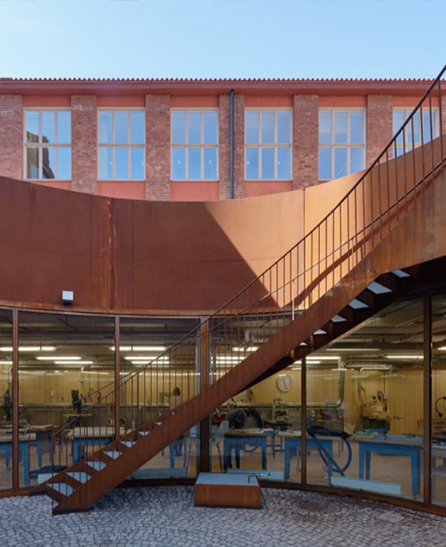
The base is located on a triangular plot on the KTH campus, with a strong cultural and historical atmosphere. The new
A588 Gr.A Weathering Steel Academy building sits in an existing courtyard, adjacent to a red brick building designed by Erik Lallerstedt in the early 20th century.
The KTH campus site, with its very tangible cultural and historical background, and its physical limitations, can be described as the opposite of a white board (Tabula Rasa). The new school inserts the existing
A588 Gr.B weathering steel courtyard space and existing paths, located in Eric Clarestedt adjacent to the original and fairly immortal brick building from the early 20th century.
The overall layout of the campus is relatively loose. Based on the same logic, the architect designed an
A588 Gr.A weathering steel building with a round shape and a free plane. The new college and base are more harmoniously integrated. The six-story teaching building includes a roof terrace and a sunken courtyard with continuous space. The Corten Steel façade echoes the surrounding dark red brick buildings.
The interior design of the
A588 Gr.A weathering steel building is very flexible. The curved wall encloses a free-flowing continuous weathering steel space, creating an atmosphere that is open rather than closed. The architect's careful design of the interior paths and windows is more like a landscape project than a traditional college building. At the entrance level, the spacious foyer can also be used as an open lecture hall. The architect also designed a series of two-story studios and exhibition halls. The corten steel exterior walls of these functional spaces enclose flexible corridor spaces.
The interior design of the weathering steel building is sturdy and flexible. The curved walls create a free flow of continuous space, enhancing the sense of openness rather than closedness. Landscapes and paths are expanded through structures, and the spatial conditions are more similar to landscapes than to traditional institutional buildings.
 The base is located on a triangular plot on the KTH campus, with a strong cultural and historical atmosphere. The new A588 Gr.A Weathering Steel Academy building sits in an existing courtyard, adjacent to a red brick building designed by Erik Lallerstedt in the early 20th century.
The base is located on a triangular plot on the KTH campus, with a strong cultural and historical atmosphere. The new A588 Gr.A Weathering Steel Academy building sits in an existing courtyard, adjacent to a red brick building designed by Erik Lallerstedt in the early 20th century.